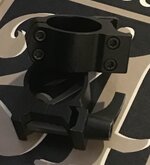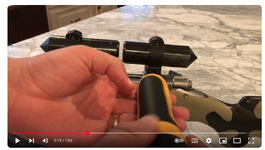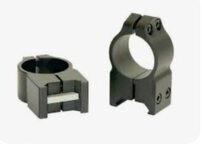Navigation
Install the app
How to install the app on iOS
Follow along with the video below to see how to install our site as a web app on your home screen.
Note: This feature may not be available in some browsers.
More options
Style variation
You are using an out of date browser. It may not display this or other websites correctly.
You should upgrade or use an alternative browser.
You should upgrade or use an alternative browser.
Vertical split rings
- Thread starter westsloper
- Start date
Ya the Warnes on my A-bolt have held the same zero for 14 years and have flown on a plane 4 times. Not gonna sweat the ones I already installed.All else being equal, I would rather have the steel Tally units (lets not get started on the Talley LW); however, I've used 20+ sets of Warnes without a single issue, and some had/have a ton of use and shooting on them, so I wouldn't fret the Warnes. And the Warnes fit a number of mounts vs Tally using a proprietary design.
TaperPin
WKR
- Joined
- Jul 12, 2023
- Messages
- 6,160
Everyone I know really likes them.You have me talked into the Talleys for future mounts. Warne lists “Sintered Steel” which is powdered metal. There are some claims for vibration dampening benefits etc. but I don’t know how much of that is snake oil. I would rather have machined parts.
If ordering from anyone other than Talley I noticed descriptions are not always clear if the ring fits the smaller dovetail base or a pic rail. At that time it seemed the pic rail rings were much less common.
The last ones I picked up last year came with both socket head cap screws and the adjustable winged screws for the base clamp.
wind gypsy
"DADDY"
- Joined
- Dec 30, 2014
- Messages
- 12,644
Thanks for the photo. I have removable ones like on the left for one of my takedown rifles and it does not change zero when you take it off and on as long as you follow the instructions and fully torque the bottom to 25 in-lbs. before setting up the top at 15 in-lbs. I hope this conversation dispels a lot of the myth surrounding these mounts. I find them ideal.
I always found this video to be a good illustration of how they count on the bottom screws to both clamp the scope and the rail.
In watching it, it doesn't seem like he changed the driver setting from 25 in-lbs on the base to 15 in-lbs on the top as you say is correct. Do you think that is why its not tight on the base? because they torqued too tight on the top that it lost it's tension on the bottom?
They rely on scope tube and/or ring deformation under torque to hold in place. Due to this, how much a scope tube deforms when torquing the top rings would seem to impact what the appropriate torque of the top screws is id think because how much the scope/rings do or dont deform should impact how tight the base screws are holding. Its a compromise without worthy justification vs horizontal split rings.
It is because a steel tube is being used. It will not allow the ring to compress uniformly and is stretching the rings of the mount and putting all of the forces into the top screws. The only part of the rings that can flex in this instance since a scope is not being used is the very top. I imagine that it is pulling the bottom apart completely. It has nothing to do with this, but I used to have that same torque wrench, and it can be off by 5 in*lbs. when compared to fix-it sticks or other better calibrated wrenches. I ended up getting rid of it. Not the issue here though.I always found this video to be a good illustration of how they count on the bottom screws to both clamp the scope and the rail.
In watching it, it doesn't seem like he changed the driver setting from 25 in-lbs on the base to 15 in-lbs on the top as you say is correct. Do you think that is why its not tight on the base? because they torqued too tight on the top that it lost it's tension on the bottom?
They rely on scope tube and/or ring deformation under torque to hold in place. Due to this, how much a scope tube deforms when torquing the top rings would seem to impact what the appropriate torque of the top screws is id think because how much the scope/rings do or dont deform should impact how tight the base screws are holding. Its a compromise without worthy justification vs horizontal split rings.
wind gypsy
"DADDY"
- Joined
- Dec 30, 2014
- Messages
- 12,644
It is because a steel tube is being used. It will not allow the ring to compress uniformly and is stretching the rings of the mount and putting all of the forces into the top screws. The only part of the rings that can flex in this instance since a scope is not being used is the very top. I imagine that it is pulling the bottom apart completely. It has nothing to do with this, but I used to have that same torque wrench, and it can be off by 5 in*lbs. when compared to fix-it sticks or other better calibrated wrenches. I ended up getting rid of it. Not the issue here though.
Different scope tubes wont compress uniformly either though. I'm sure some tubes are much thinner walled than others.
TaperPin
WKR
- Joined
- Jul 12, 2023
- Messages
- 6,160
The only function of the single screw is to tighten the ring onto the base, so why wouldn’t he do that? Did he get into grandmas Oxycodone prescription?I always found this video to be a good illustration of how they count on the bottom screws to both clamp the scope and the rail.
In watching it, it doesn't seem like he changed the driver setting from 25 in-lbs on the base to 15 in-lbs on the top as you say is correct. Do you think that is why its not tight on the base? because they torqued too tight on the top that it lost it's tension on the bottom?
Yes, you’re also right the bottom double screw should be tighter than the two screws on top.

wind gypsy
"DADDY"
- Joined
- Dec 30, 2014
- Messages
- 12,644
What are you suggesting? The 25 in-lb he tightened the base to (which apparently is warnes published direction) is not sufficient?The only function of the single screw is to tighten the ring onto the base, so why wouldn’t he do that? Did he get into grandmas Oxycodone prescription?
TaperPin
WKR
- Joined
- Jul 12, 2023
- Messages
- 6,160
Oh I get it, the idea was to show how tension on the base changes as the scope tube is clamped and where the bottom two screws are acts like a hinge. Yeah, those bottom two need to be cranked down tight so it can’t hinge.
TaperPin
WKR
- Joined
- Jul 12, 2023
- Messages
- 6,160
He didn’t even touch the screw for the base clamp. There are 5 screws on these rings - he only tightened 4.What are you suggesting? The 25 in-lb he tightened the base to (which apparently is warnes published direction) is not sufficient?
wind gypsy
"DADDY"
- Joined
- Dec 30, 2014
- Messages
- 12,644
TaperPin
WKR
- Joined
- Jul 12, 2023
- Messages
- 6,160
The other side of the rings have the 5th screw. It’s either an intentional misrepresentation or Oxy.Huh? He showed the torque value on the driver, then showed torquing both base screws until the driver clicked.
View attachment 851622
5811
WKR
- Joined
- Jan 25, 2023
- Messages
- 1,001
Vertical split rings are a poor solution looking for a problem that doesn't exist. Any variability in base dimensions can be translated to the ring torque/clamping force. If the base is narrow, the top is flexed further apart.I always found this video to be a good illustration of how they count on the bottom screws to both clamp the scope and the rail.
In watching it, it doesn't seem like he changed the driver setting from 25 in-lbs on the base to 15 in-lbs on the top as you say is correct. Do you think that is why its not tight on the base? because they torqued too tight on the top that it lost it's tension on the bottom?
They rely on scope tube and/or ring deformation under torque to hold in place. Due to this, how much a scope tube deforms when torquing the top rings would seem to impact what the appropriate torque of the top screws is id think because how much the scope/rings do or dont deform should impact how tight the base screws are holding. Its a compromise without worthy justification vs horizontal split rings.
I'm a hater because they wouldn't even tighten on my ruger at the base. They are very sensitive to base dimensions by design, and there is zero technical justification for this design, only drawbacks.
TaperPin
WKR
- Joined
- Jul 12, 2023
- Messages
- 6,160
TaperPin
WKR
- Joined
- Jul 12, 2023
- Messages
- 6,160
Another reason to stick with Talleys. 
wind gypsy
"DADDY"
- Joined
- Dec 30, 2014
- Messages
- 12,644
The other side of the rings have the 5th screw. It’s either an intentional misrepresentation or Oxy.
I see. So is the quick release lever supposed to be full open when torquing the base screws, then torque the top screws, then turn the quick release lever?
I would have assumed the quick release was fully tight when the base screws were torqued to ensure a more accurate torque value than a QR lever..
TaperPin
WKR
- Joined
- Jul 12, 2023
- Messages
- 6,160
The qr lever (or single screw) is loose until the bottom ring screws are tightened. The qr lever (or single screw) then locks the ring to the base and lastly the top screws locks the scope in place. Talleys ship with both a single screw and qr wing. I think you’re right about the wing not providing a very good way to get accurate torque.I see. So is the quick release lever supposed to be full open when torquing the base screws, then torque the top screws, then turn the quick release lever?
I would have assumed the quick release was fully tight when the base screws were torqued to ensure a more accurate torque value than a QR lever..
TaperPin
WKR
- Joined
- Jul 12, 2023
- Messages
- 6,160
Thanks for posting that video - I thought I’ve been going crazy the past few years arguing for the 5 screw rings while so many were talking about a completely different design in the 4 screw model.
wind gypsy
"DADDY"
- Joined
- Dec 30, 2014
- Messages
- 12,644
The qr lever (or single screw) is loose until the bottom ring screws are tightened. The qr lever (or single screw) then locks the ring to the base and lastly the top screws locks the scope in place. Talleys ship with both a single screw and qr wing. I think you’re right about the wing not providing a very good way to get accurate torque.
I had to go back and look again - I assumed the base screws were torquing to the same clamp as the QR lever but it seems like they are strictly clamping the scope and the QR lever is the sole source of clamping the rail? So basically they function similarly to 4 screw horizontal cap screws but instead of a scope resting on the bottom half prior to screw tightening its resting beween two halves. I dont see the benefit to being vertical there either?
TaperPin
WKR
- Joined
- Jul 12, 2023
- Messages
- 6,160
Yes, I think you have it right. There’s no real benefit to being vertical other than the slim shape of the rings.I had to go back and look again - I assumed the base screws were torquing to the same clamp as the QR lever but it seems like they are strictly clamping the scope and the QR lever is the sole source of clamping the rail? So basically they function similarly to 4 screw horizontal cap screws but instead of a scope resting on the bottom half prior to screw tightening its resting beween two halves. I dont see the benefit to being vertical there either?
Similar threads
- Replies
- 0
- Views
- 976
Featured Video
Latest Articles
- TT#64 Josh Boyd Elk Hunting Strategies for Every Season
- Aaron Davidson of Gunwerks
- TT#63 Dirk Durham’s Art of Elk Calling
- BIG Buck Stories with the Dirty Giants Podcast
- TT#62 Brian Barney Hunting Bulls without Calling
- Hoyt Alpha AX-2 SD Review
- Kuiu Kenai vs Outdoor Vitals Vario Hooded Jacket Review
- Hoyt RX-9 Ultra Review
- Hunting Vampire Bucks & Building an Optics Kit
- Darton Sequel ST2 35 Review


